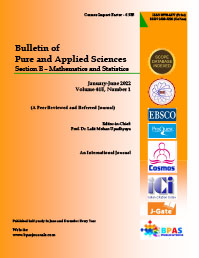DISPERSION OF SOLUTE WITH CHEMICAL REACTION IN BLOOD FLOW
DOI:
https://doi.org/10.48165/Keywords:
Chemical reaction, magnetic field, Taylor dispersion modelAbstract
A mathematical model is developed to study the influence of an externally applied magnetic field and chemical reaction on the flow characteristics of blood in the presence of mild stenosis. The equations of momentum are solved under appropriate boundary conditions using Hankel transform. Taylor's dispersion model [17] is used to obtain dispersion of solute in blood flow. The effects of various parameters entering into the problems are discussed numerically and explained graphically.
References
Bali, B. and Awasthi, U. (2011). Mathematical model of blood flow in the small blood vessel in presence of magnetic field, Applied Mathematics, Vol. 2, 264–269.
Bhatnagar, A., Shrivastav, R.K. and Singh, A.K. (2015). A numerical analysis for the effect of slip velocity and stenosis shape on Non-Newtonian flow of blood, International Journal of Engineering, Vol. 28 (3), 440-446.
Bunony, K.W., Israel-Cookey, C. and Amos, E. (2018). Modeling of Blood Flow through Stenosed Artery with Heat in the Presence of Magnetic Field, Asian Research Journal of Mathematics,Vol. 8(1), 1-14.
Casson, N. (1958). A flow equation for pigment oil suspension of the printing ink type, in Rheology of Disperse Systems, Pergamon Press, New York.
Chaturani, P. and Mahajan, S.P. (1982).Poiseuille flow of micropolar fluid with non-zero couple stress at boundary with applications to blood, Biorheology, Vol. 19(4), 507-518.
Cokelet, G.R. (1972). The rheology of human blood, in Biomechanics, Edited by Fung, Y.C. et al., Prentice Hall, Englewood Cliffs, New Jersey.
Haldar, K. and Ghosh, S.N. (1994). Effects of a Magnetic Field on Blood Flow through an Indented Tube in the Presence of Erythrocytes, Journal of Pure and Applied Mathematics, Vol. 25, No. 3, 345- 352.
Eldesoky, Islam M. (2012). Slip Effects on the Unsteady MHD Pulsatile Blood Flow through Porous Medium in an Artery under the Effect of Body Acceleration, International Journal of Mathematical Sciences, Article ID 860239, (2012), 26 pages.
Kumar, S. and Sharma, M.K., Singh, K. and Garg, N.R. (2011). MHD two-phase blood flow through an artery with axially non-symmetric stenosis, International J. of Math. Sci. & Engg. Appls. (IJMSEA). 5(11), 63-74, 2011.
Layek, G.C. and Mukhopadhyay, S. (2008). Numerical modeling of a stenosed artery using mathematical model of variable shape, Int. J. of Applications and Applied Mathematics,Vol. 3, 308- 328.
Mekheimer, Kh.S. and El Kot, M.A. (2008). Influence of magnetic field and Hall currents on blood flow through a stenotic artery, Appl. Math. Mech. Engl. Ed., Vol. 29(8), 1093-1104.
Shukla, J.B., Parihar, R.S. and Rao, B.R.P. (1980). Effect of stenosis on non-Newtonian flow of blood in an artery, Bull. Math. Biol., Vol. 42, 283–294.
Shukla, J.B., Parihar, R.S. and Rao, B.R.P. (1980). Biorheological aspects of blood flow through artery with mild stenosis: effects of peripheral layer, Biorheology, Vol. 17, 403–410.
Srivastava, V.P.and Saxena, M. (1994). Two-Layered Model of Casson Fluid Flow through Stenotic Blood Vessels; Applications to the Cardiovascular System, Journal of Bio-mechanics, Vol. 27, 921- 928.
Tandon, P.N. and Agarwal, R. (1989). A Study of Nutritional Transport in Synovial Joints, Computers & Mathematics with Applications, Vol. 17, No. 7, , 1131-1141.
Tandon, P.N., Nirmala, P., Tewari, M. and Rana, U.S. (1991). Analysis of Nutritional Transport through a Capillary: Normal and Stenosed, Computers Math. Applic. Vol. 22(12), 3-13. [17] Taylor, G.I. (1953). Dispersion of soluble matter in solvent flowing slowly through a tube, Proceedings of the Royal Society, 219(1137) (1953), 186–203.
Tripathi, D. (2012). A mathematical model for blood flow through an inclined artery under the influence of an inclined magnetic field, Journal of Mechanics in Medicine and Biology, Vol. 12, 1–18.
